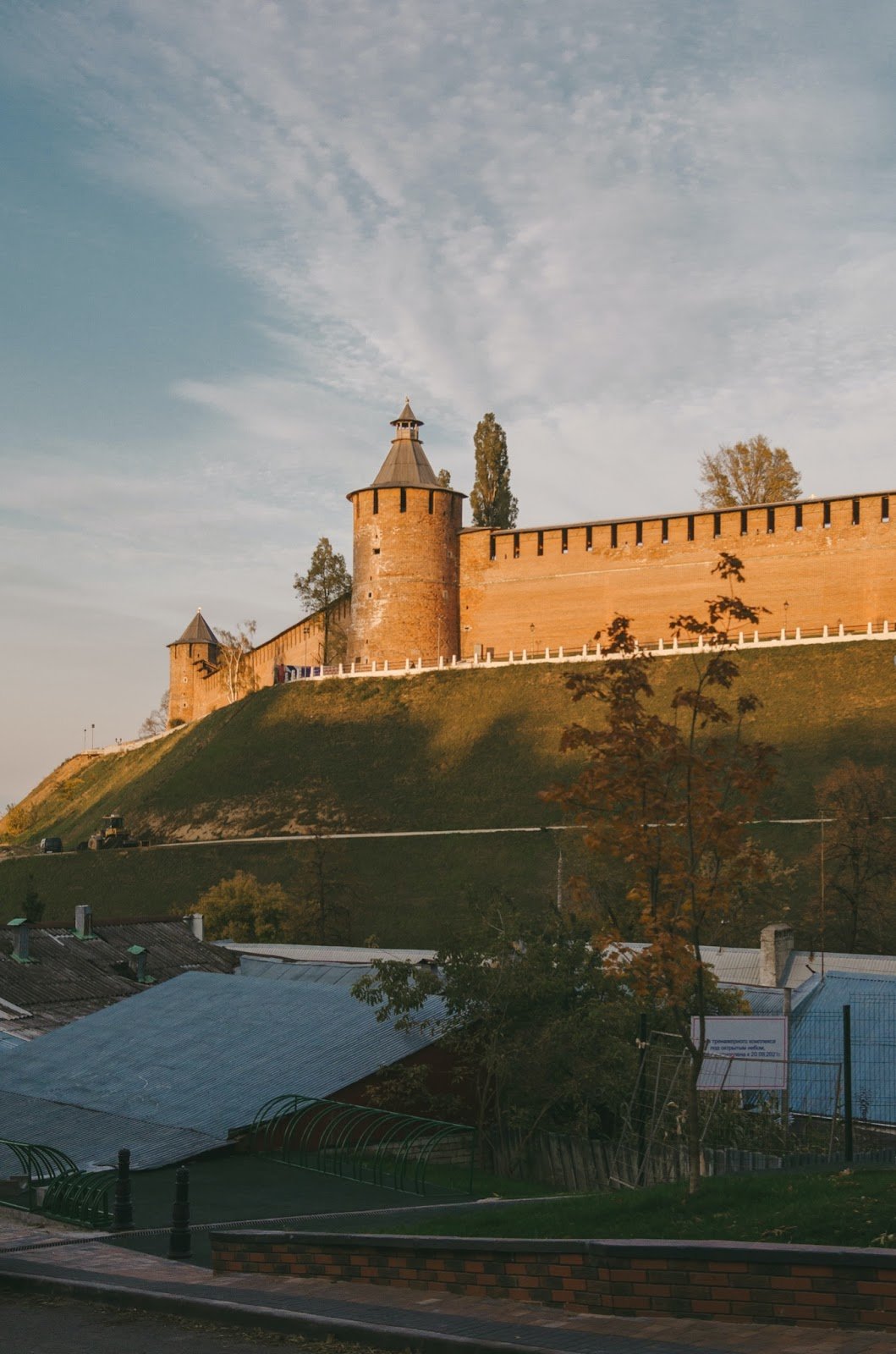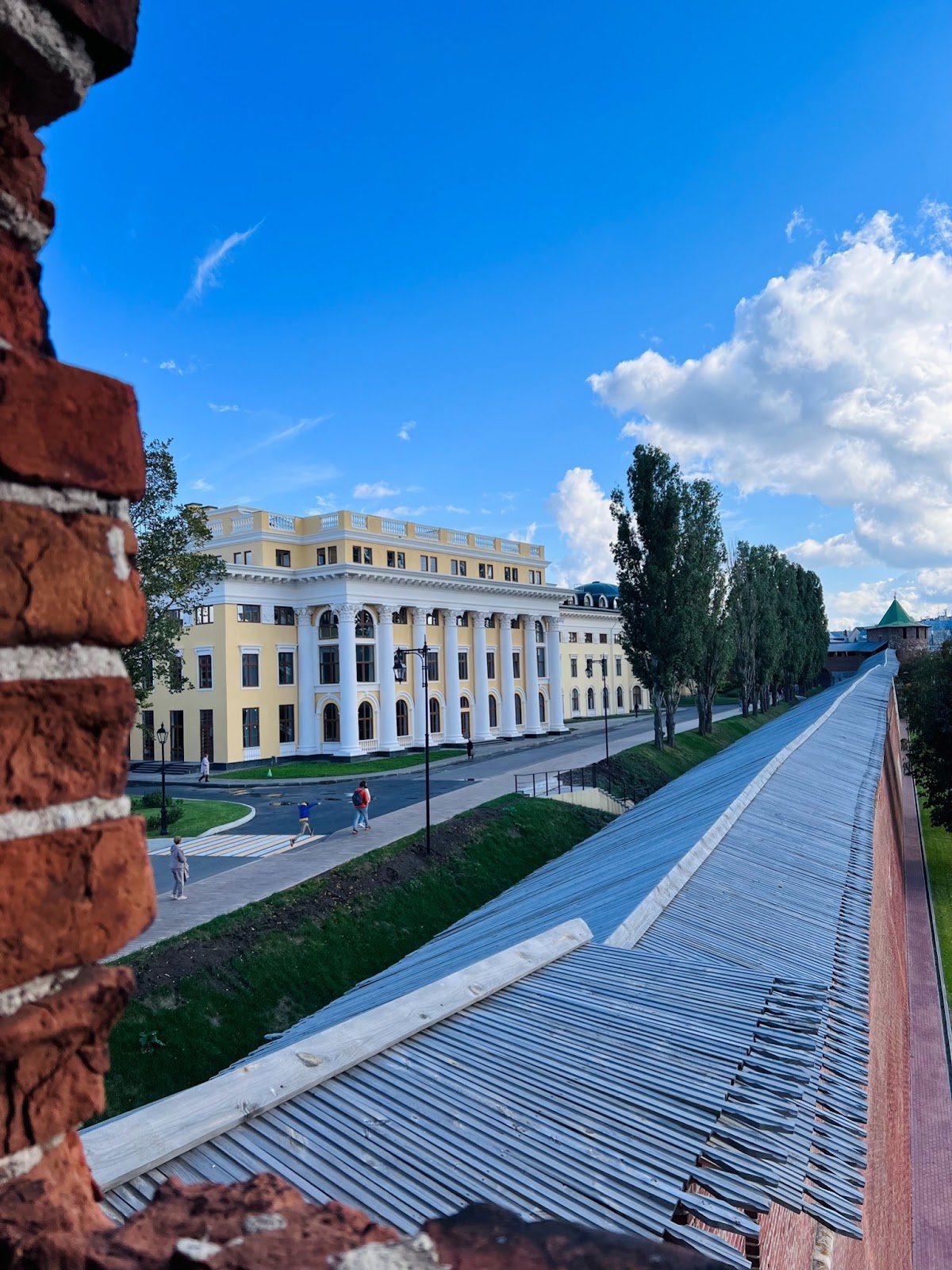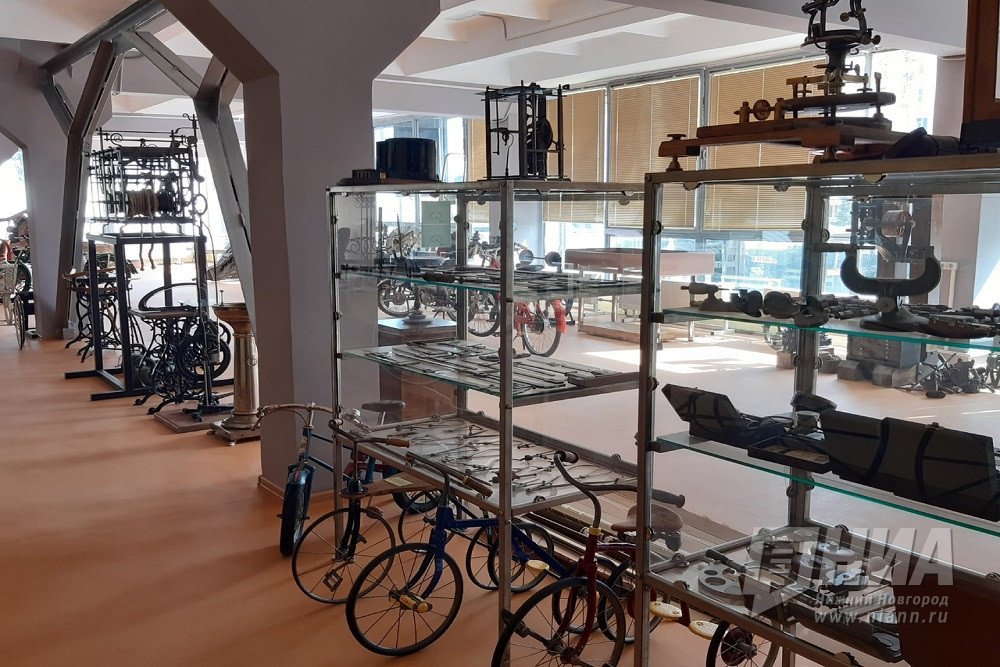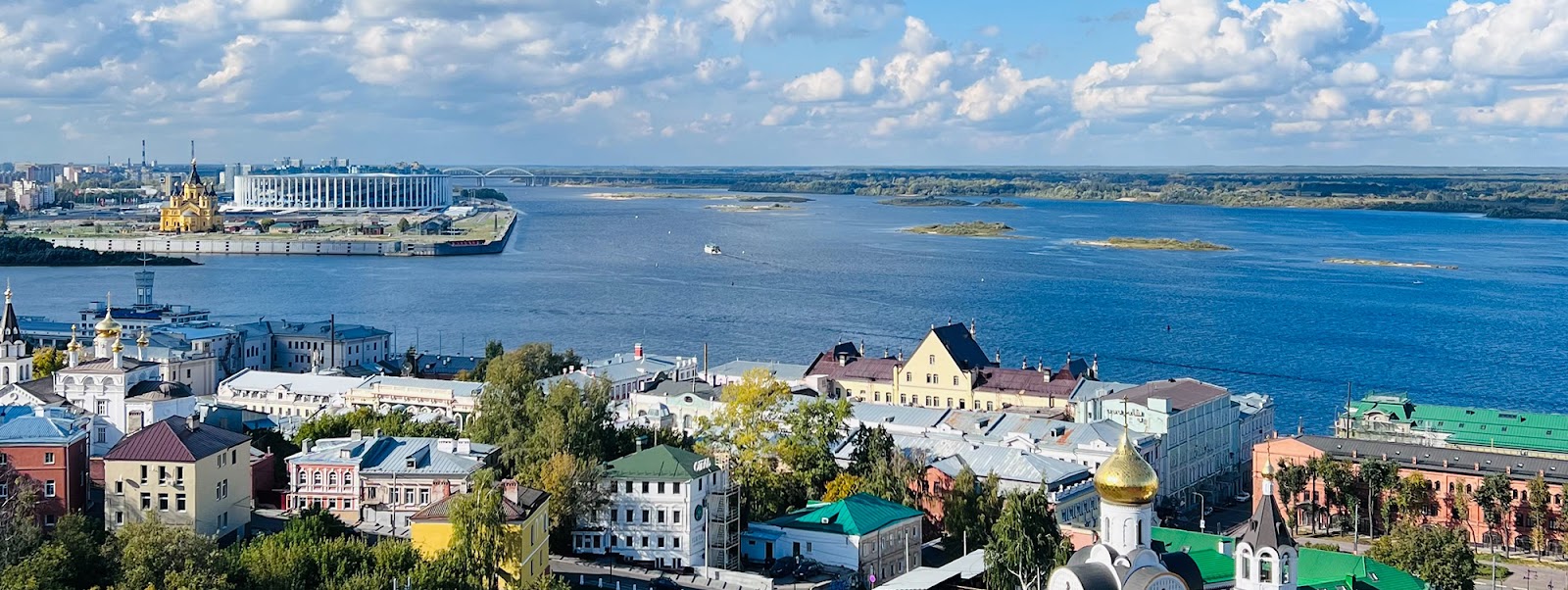Vladimir Vaskevich, sightless traveler, host of As Far As Eyes Can’t See travel show (Kuda Glaza Ne Glyadyat) and Special View correspondent, continues to inform us about the Russian cities which are most accessible for sightless tourists. In this article, you will learn about the most interesting sites of Nizhniy Novgorod.
Nizhniy Novgorod is situated at the confluence of two great rivers, Volga and Oka. For more than half a century, it carried the name of Gorky, one of the prominent Soviet writers. Here one can find one of Russia’s longest stairways, and the country’s longest cable way. These are just a few interesting facts about the capital of the Volga region. Learn more about Nizhniy Novgorod in the following article.

Audio description: a colored photo. A sunny autumn afternoon is waning. At the top of a green hill, a part of Nizhniy Novgorod kremlin can be seen. Ramparts with arrow holes connect circular red-brick towers. Behind the city walls, trees with withered leaves are showing. Weightless clouds are sailing across the sky.
Visiting Nizhniy Novgorod’s kremlin
To get acquainted with Nizhniy Novgorod, one should start with its old town. In order to do this, let’s go to the kremlin, a unique military engineering construction which in 1221 started off the building of the town itself. The first kremlin was made of wood, but in time, it was reinforced with stone towers, and its current appearance dates back to early XVI century.
The fortress is situated on the bank where Volga and Oka rivers meet. Its walls seem to descend like gigantic steps from the Minin and Pozharsky Square to the foot of the hill. The top elevation of the red-brick ramparts upon the hill measures almost 82 meters higher than that of the lower ones. The kremlin has 13 stone towers and it encircles 23 hectares of land.
In 2021, to honor the city’s 800th anniversary, the kremlin introduced a unique tourist route along its walls. This is the route I recommend to take first off.
Following the banquette, one can find many stone stairways, arrow holes, and also museums and exhibitions inside the towers. What is unique about the kremlin is that it was constructed in XVI century by Piettro Francesco (in Russian, Pyotr Fryazin), an Italian architect at сzar Vasily III service. The legend says that Francesco was an apprentice of Leonardo da Vinci himself. Perhaps, this is why no enemy managed to seize the kremlin in all of its history.
The portion of the wall from the main Dmitriyevskaya tower to the Chasovaya tower (Clock tower), where most of the observation points and exhibitions are concentrated, is open for visitors all year round. However, the circular route is available only in the warm moths, as some parts of the route have huge steps which are not safe to climb in winter or during autumn rains. One can walk atop the ramparts either unassisted using white cane, or with a tour guide.
For people with group I disabilities, walking atop the city walls is free of charge.
For more information about guided tour programs and any other details, dial
In addition to the tour along the ramparts, one is highly recommended to peep into the fortress itself. Here you will find one of the oldest buildings in the city, the Archangel Michael’s Cathedral. This is the place where Kuzma Minin (merchant and one of the leaders in the war against Poland) is buried, and this church became a site of pilgrimage.
Not far from the cathedral, one can visit the obelisk to Minin and Pozharsky erected in XIX. At first it had been planned to put a monument here, but when the sum necessary for its creation was accumulated, it was decided to install the monument in Moscow’s Red Square, and the obelisk was deemed to be enough for Nizhniy Novgorod.
Beside the obelisk, you can appreciate one of the city’s most spectacular sightseeing platforms where visitors may admire the view at Volga and Oka rivers. Here one can see the triangle of dry land separating the two rivers. This cape, so to say, accommodates city fair, the stadium built for the World Football Cup, and Alexander Nevsky Cathedral. Perhaps, such information may be of little interest for a sightless tourist, but I recommend to go there anyway, to stand and ponder for a while, certainly to take a selfie and breathe in fresh river air.

Audio description: a colored photo. A bright summer afternoon. Beyond the red-brick rampart one can see a long four-storied yellow building in classic style, with rows of arched and rectangular windows. This is the Armory. It is decorated with white semi-columns and a crenelated moulding. Grassy lanes and asphalt paths run along the building.
Inside the kremlin, it is worth noting another interesting historic building constructed under the order of Czar Nicolas I, namely the Armory building, monumental in its
Note that it is impossible to simply walk from one wing of the building into the other one. It is better to choose in advance which event you are going to visit, an exhibition or a lecture. As local sightless activists say, exhibitions here are changing frequently, but the museum administration gives much effort to create an accessible environment, and tourists with disabilities, including sightless travelers, are always welcome here. For more details, visit the museum’s official website or dial
Flying Over The Volga River
If you walk out of the kremlin into The Minin and Pozharsky Square and then turn left, you will reach Verkhne-Volzhskaya (Upper Volga) embankment. You will be flanked by a row of merchants’ manors on the one side and the Volga’s expanse on the other. If you walk down the embankment to the Sennaya Square, you will find the cable way station. Nizhniy Novgorod residents call it The Record Breaker.
It is considered to be Russia’s longest cable way, and its main span runs across the country’s widest navigable river. The total length of the cable way tops 3.5 km, and the time one spends in the
Nevertheless, it was built for practical reasons: every day hundreds of people commute to Nizhniy Novgorod from the town of Bor, going to the office or other destinations. The view from the cabins is breathtaking, that is why the cable way soon gained popularity among tourists. So I advise you to hop on, too. Even if you are unable to see the view, I guarantee you will feel as if you were flying. I’ve found this out myself, being a sightless tourist.
The cable way staff are friendly; they assist sightless visitors to board and exit the cabin. If necessary, they can have the cabins fully stopped for people to walk in with no haste. The address of the boarding point in Nizhniy Novgorod is 8 Kazanskaya embankment. For more details about ticket prices and the cable way opening hours, follow this link or dial
If you are not ready to glide over the Volga river at once, you may leave the kremlin and go to Chkalov’s monument, and from there you may descend one of Russia’s longest stairways. It begins at the viewpoint near the Georgiyevskaya tower of the kremlin.
Chkalov Stairway was built in the middle of the XX century to honor the victory in Stalingrad battle. The architects designed the stairway to resemble the figure 8. The circles symbolize the Russian forces being entrapped, and its lower straight part stands for Soviet soldiers breaking through the ring. The stairway was first named The Stalingrad Stairs, then The Volga Stairs, but these names didn’t gain much popularity. Most often, the locals call this gigantic construction The Chkalov Stairs, meaning the neighboring monument to Valeriy Chkalov, Soviet test pilot.
The stairs will lead you to the Nizhne-Volzhskaya embankment (Lower Volga embankment), which is divided into two parts, one for vehicles, and the other for pedestrians and bikes. In a hot day, one may enjoy fresh river breeze here. Having walked along the embankments to our satisfaction, let’s move further, to the street which greatly resembles Moscow’s Arbat.
Bolshaya Pokrovskaya St. Sculptures
Bolshaya Pokrovskaya St. is a perfect place for leisured walks. Its major pedestrian part lies between the Minin and Pozharsky Square and the Gorky Square. In addition to numerous boutiques and coffee shops, this street is famous for its sculptures. You may touch all of them.
For example, in a mini-park at the Minin and Pozharskiy Square, there are two sculptures to the seller and the buyer of the Iz Ruk V Ruki pennysaver. Tourists like these peculiar and interesting sculptures. The locals often joke that the person who manages to pry the lowermost newspaper from the seller’s hands is going to be rich.
At the very beginning of the street, on your left, you will find the sculpture of the XIX century policeman. He is wearing full uniform, and there is a sabre (shashka) and a revolver at his belt. This sculpture became a part of Nizhniy Novgorod
The next sculpture on your way will be the shoeshiner. It is a sitting boy in an apron holding black polishing brushes. In front of him, there is a wooden box. In XIX century, the job of a shoeshiner was one of the most popular ones. They often greeted visitors by the entrance to a hotel or a restaurant and heartily offered their services.
To honor late XIX century masters of photography, a photographer’s sculpture was also erected in B. Pokrovskaya St. It will be the next sculpture on your right. It is a cast-iron monument of a photographer with an old-type photo camera and a big tripod. Opposite the camera you will find the photographer’s model, a cute little dog.
Let’s go further down the street. At the point where B. Pokrovskaya St. crosses Pisunova St. you will find one of the city’s most popular sculptures, the cheerful nanny goat. It is dancing, playfully raising one hoof and throwing its head back. People say that if you grasp its horns, luck will surely smile upon you. The tourists are always crowding around this sculpture.
Now let’s proceed to the Teatralnaya Square, and we will find two more interesting sculptures on our way. On a bench by M. Gorky Drama Theater, there is the monument to a famous Nizhniy Novgorod citizen, actor Yevgeniy Yevstigneyev. His career began in this very theater. And now local actors rub the figure’s nose for luck before every performance. A little further, by house number 15, you will find a sculpture of a young violin player.
Next to the State Bank building, to your left, there will be the sculpture of a tavern owner inviting passers-by to visit his establishment. On a bench opposite The Puppet Theater, there is a governess with her pupil.
Follow the street and you will find more noteworthy sculptures of Nizhniy Novgorod XIX century citizens. For example,
-
a doorman welcoming you to the restaurant,
-
a family of aristocrats (according to a legend, the prototype for this sculpture group was a family of a Decembrist rebellion participant, who was exiled for over 30 years, but then came back to Nizhniy Novgorod and began to take an active part in the city’s social life),
-
a lady with a mirror which all young women are trying to look into.
The sculpture that concludes this parade stands in the very end of the B. Pokrovskaya St. and is traditional for many cities. It is a figure of a postman with a bicycle. He is leaning on his iron horse, and a satchel with letters is hanging on his shoulder.
Nizhniy Novgorod Museums For Sightless Tourists
B. Pokrovskaya St. is famous not only for its numerous sculptures, but also for its interesting museums. Two of them share one building, 43 B. Pokrovskaya St.
Unfortunately, at present, the Museum Of Artistic Craftwork is not very accessible for sightless tourists, but its employees assure me that the work on the museum tour adaptation is already in progress. However, if you wish to touch pieces of folk art anyway, you may visit the souvenir shop at the ground floor.
If you manage to charm the salesperson, you will be allowed to touch czar’s dinnerware and Christmas decorations with Khokhloma ornaments, Semyonov factory Matryoshka dolls with crimson roses, chests with Gorodets painting and various souvenirs.

Audio description: a colored photo. A brightly lit exhibition hall with picture windows at the Technology Museum. Various devices are displayed in three-tiered glass cases. Vintage kid’s bicycles are arranged on the floor along the cases.
The second museum occupying this building is The Technology Museum, and it is of great interest for visually challenged tourists. It is located at the second floor. Touching the exhibits is not just allowed, but highly recommended. This museum was founded by Vyacheslav Khurtin who has been collecting and repairing vintage machines and devices for many years. His private collection has become a full-scale museum, and now everyone who so wishes may touch the progress.
Here you can find an old-time carriage, sleighs, carts, typewriters, a diving suit, perambulators, clocks and many other fascinating items. You may even listen to a gramophone playing music and appreciate the quality of the sound. You may touch old-time medical appliances, for example, a huge brass syringe and an intimidating
What is more, the same building is home to the Tasteful Theater (Teatr So Vkusom). It is not exactly a museum, but an amazing place anyway. Here, every guest becomes an actor and a chef, has a chance to feel the atmosphere of the epoch and place depicted in the performance.
You will be surprised at historical facts and culinary secrets, try to puzzle out the bouquets of smells, listen to delicate music and take part in cooking the courses and tasting them. The theater offers more than ten performances, so even true foodies will find a program to their taste. You are guaranteed to enjoy the delicious meals and feel elation surrounded by you nearest and dearest (if you are planning a group visit).
For more details, follow the link or dial
One more highly interesting tactile museum in Nizhniy Novgorod is the Museum of Living Paper (Muzey Zhivoy Bumagi) situated at 2/2 Minina Square. All the exhibits and toys here are papier-mache, that is, formed of paper and glued with flour paste. When you touch them, you will be amazed that even some chairs, tables and walls of the museum are made of paper.
The museum founders and its craftspeople are full of ingenuity and often present their pieces with much humor. While examining the display, you will find Artyomka, the Snowman, Klava, the Enamored Cow, the Mad Hatter’s Hat, a Gypsy crow, donkeys Pavlusha and Gavryusha and other amusing characters.
The museum employees give group and individual guided tours with photo sessions. Moreover, you may take part in a workshop and create your own papier-mache toy. For details, visit the museum’s social network page or dial
Nizhniy Novgorod’s Activities Available for Sightless Tourists
To those who like adrenaline and wish to work out a bit, Nizhniy Novgorod offers Vysota ropes park, a climbing center and a trampoline park. You may say that such activities can be found in any city; however, not all of them are ready to welcome visually impaired guests.
It is better to go there accompanied by a friend with partial vision or with no visual impairments, but, according to the local citizens, the instructors welcome all guests with equal hospitality. They will explain to you everything you need to know, and show you how to use the safety wire and carabiners by feel.
You will be climbing the ropes at 3 plus meters above ground, negotiate rope loops, swinging bridges and other constructions. And if that is not enough, you may visit a climbing center and a trampoline park nearby. Vysota park is open all year round; find it at 7B Verkhne-Pecherskaya St., Olymp mall. For more information, dial
Animal lovers will certainly enjoy a visit to a horseback riding school at Nadezhda animal training center. For more than 20 years, the school has been breeding horses and training people of all ages to ride. The school has educated dozens of competitions winners. What is more, in the recent years it has been developing adaptive sports for people with disabilities, and organizing hippotherapy workshops.
At the moment, the center is training about 30 children with various impairments, including visual challenges. All the guests learn about different breeds of horses, train to get along with animals and have the opportunity to ride a horse. Those who are not new to this sport may take a ride to a forest or to a nearby lake, naturally, accompanied by an experienced instructor. The address of the center is 1V Zaprudnaya St., and if you have more questions, dial
Some Extra Information For Sightless Tourists Planning To Visit Nizhniy Novgorod
Nizhniy Novgorod is a city with many centuries of history and fascinating places of interest. And most importantly, there are enough objects accessible for a sightless tourist; so many that it will take more that two days to visit them. In this article we were not able to mention all of them.
Come to this city for a number of days, use the material above and certainly check out the account of Nizhniy Novgorod Camerata center, which regularly posts advertisements of performances and film shows with audio description, free guided tours and interesting workshops.


